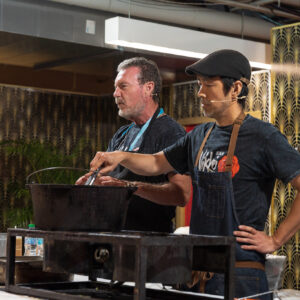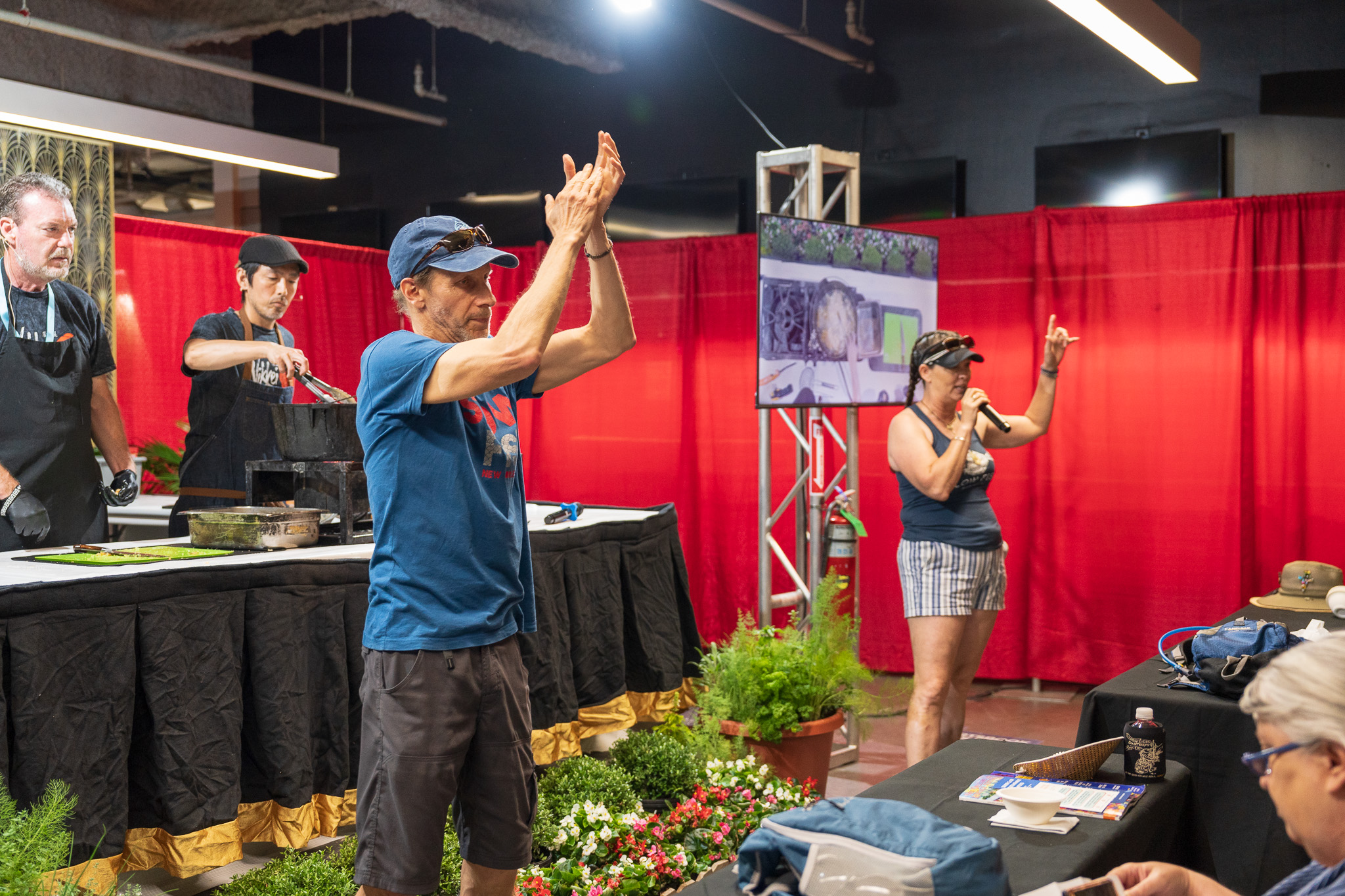Food is a great vehicle for storytelling. Not only can you dive into the story of ingredients, but you can also share the cultural and ecological (terroir, merroir) narratives that shape flavor, appearance and experience.

Dana describes kakiage, the process, and the why he sources local seafood at Nikkei Izakaya. Photo: Margaret Crosby
Collaborating with Slow Fish North America, Slow Food USA and other values-aligned networks, we’ve wrapped effective storytelling around food in KNOW FISH Dinners®, Seafood Throwdowns and Chefs Camps. In each experience, we talk about learning the story of your seafood, building relationships and spreading the message.
Such was the connectivity and focus of a recent cooking demonstration hosted by chefs Dana Honn, Wataru Seiki and Christina Honn of Nikkei Izakaya during the New Orleans Jazz & Heritage Festival. About 100 people packed into the room to watch Wataru and Dana make kakiage, a Japanese tempura featuring vegetables and locally sourced domestic shrimp.
Attendees also heard the story of the shrimp, the shrimp industry, and how the complex, industrialized seafood supply chain has been forcing shrimpers out of business along the Gulf Coast.
Boats staying tied to the dock
Cheap, imported farmed shrimp has been flooding US markets for the past several years, with a devastating impact on local shrimp markets. I provided some context about how the dock price (the price processors pay shrimpers) dropped from about $4 per pound in April of 2021 to less than 60 cents in Nov. of 2023. Overall industry revenue has dropped too. The value of 57 million pounds of Louisiana caught white shrimp in 2013 was $128 million. Last year, 52 million pounds of white shrimp was worth just $54 million.

Captain Kindra Arnesen describes the effort to combat industrialization and consolidation in the seafood industry. Photo: Margaret Crosby
With dock prices and overall value so low, many domestic shrimpers have been forced out of business. Factor in the cost of fuel, crew, insurance, boat payments, etc., and many shrimpers decided it was more affordable to keep their boats on the dock. The number of shrimp licenses in Louisiana has dropped from about 2,500 in 2010 to about 850 last year.
Captain Kindra Arnesen, who runs a seafood business with her fisherman husband David in Buras, talked about how the economic stress continues to affect fishing communities throughout the south. She explained how she and David kept their shrimp boat tied up for the past couple of years.
They recently hired someone to take out their boat shrimping this season as prices have begun to rise.
Building a counter narrative

Emma Reid talks about community building around the local shrimp industry while Wataru checks the oil temperature. Photo: Margaret Crosby.
Dock prices have slowly begun to rise recently as a steady counter-narrative has spotlighted the impact of cheap imported shrimp and the mislabeling that happens too often. Emma Reid, one of the principals along with Dana behind Shrimp Aid, told the Jazz Fest audience about critical steps to educating the public about what’s at stake.
Shrimp Aid is an initiative that supports the domestic, wild caught shrimp industry via education, advocacy and community engagement. One such engagement was the inaugural Louisiana Shrimp Festival that took place last fall.

Portioning the kiakiage, which was promptly devoured by the audience. Photo: Margaret Crosby.
Part of the education message for Shrimp Aid, Louisiana Shrimp Festival, and across organizations and networks like One Fish Foundation, Slow Fish, Local Catch Network and others is to get folks to ask questions about the seafood they buy, learn where it’s from, and take ownership of their relationship to seafood and the people who produce it. As Kindra said, seafood eaters depend on local fisherfolk to feed them, just as fisherfolk depend on seafood eaters in their communities and regions to choose local seafood. “We’re working to feed y’all,” she told the crowd.
DNA testing of shrimp sold at restaurants, markets or festivals and conferences has complemented the public education message around the shrimp industry. Seafood mislabeling (customers pay for what they think is domestic, but get imported shrimp, often farmed with nasty chemicals) is widespread. As much as 90 percent of the shrimp that is imported is farm raised, and much of that contains banned antibiotics the FDA deems carcinogenic.
Truth in labeling
Mislabeling has become a big problem with the flood of imported shrimp. Texas-based SeaD Consulting has conducted rapid PCR testing (similar to the type of testing for Covid) that determines whether shrimp is domestic or imported, finding high rates of fraud at some festivals and in some coastal communities along the Gulf Coast and the southeast. Several news outlets have reported on instances of mislabeling.
And some states like Louisiana and Alabama have enacted laws mandating restaurants label imported shrimp and crawfish, with increased inspections and fines for those who don’t comply. Other states are following suit. According to advocacy group Southern Shrimp Alliance, states with clear imported shrimp labeling laws like Louisiana and Alabama have a lower mislabeling rate (36% of restaurants tested) than states with no restaurant labeling laws (78%).

Christina adds the last zip of flavor to complement the great storytelling. Photo: Margaret Crosby
The messaging, and these types of public engagements such as the cooking demo at Jazz Fest and the Louisiana Shrimp Festival seem to be having an impact. Not only are the dock prices rising steadily, but the incidents of restaurants being caught mislabeling imported shrimp have also gone down in areas like New Orleans and Baton Rouge as public awareness has grown.
Yes, food is an essential ingredient for public engagement around food systems conversations. So is the storytelling that comes from lived experience, passion and science. That pairing of food and storytelling makes for a great menu for changing appetites and seafood systems.
Top photo, left to right: Chefs Dana Honn and Wataru Seiki, Colles and Captain Kindra Arnesen, motivating the crowd to buy local shrimp. Photo credit: Margaret Crosby


